We spend so much energy balancing our work and personal lives, but forget how important our physical sense of balance is. This is where yoga balance poses come into play as they help you to find stability in our everyday activities – both physically and mentally. Balancing poses in yoga can prevent us from injuries, improve our focus, and help us to relieve stress.
Did you know that maintaining our (physical) sense of balance is quite a complex interaction between various bodily systems? The sense of touch, the vestibular system in the inner ear, and our sense of vision all have to work together to send the right signals to our central nervous system so that we can balance.
I’m sure you have at some point slipped or tripped over, struggling to find your balance again. You surely also know that standing on one leg requires a certain degree of equilibrium in order to not wobble or fall.
There are also some sports like surfing, snowboarding, and skating that require an extra amount of balance. But also everyday activities such as walking, stepping up the stairs, or carrying your groceries require us to stay balanced.
The good news is: yoga balance poses can help! While a regular well-rounded yoga practice helps you to improve your overall strength and stability, there some poses that are specifically aimed at improving your balance.
Let’s find out more about yoga balance poses:
“Balance is the key to everything. What we do, think, say, eat, feel, they all require awareness, and through this awareness we can grow.”
1. What Are the Benefits of Balancing Yoga Poses?
There’s a vast variety of yoga poses that help us to find more stability and balance. You probably first think of standing balancing poses and arm balances. But there are also balance poses in yoga that are practiced on all fours or seated. Note that inversions are balancing poses, too. While each pose has its unique beneficial effects, all yoga balance poses have some common benefits.
1. Physical Benefits
Balancing poses in yoga positively impact both our physical and mental health. In our body, they help us to align ourselves, to strengthen and lengthen our muscles, and to explore our center of gravity. Regular practice of balance poses can improve the function of the body’s equilibrium receptors. These are located in the vestibular system in the inner ear and provide information that enables the body to stay balanced.
There are two types of equilibrium receptors in our body: dynamic and static. The dynamic equilibrium receptors provide information about the position of the body in response to movements such as rotation, acceleration, and deceleration. The static equilibrium receptors, on the other hand, recognize the body’s position in relation to gravity, i.e. whether we’re standing upright or lying down.
2. Mental Benefits
But having a good sense of balance is so much more than just being able to stand on one foot. Apart from physical stability, yoga balance poses also help us find mental and emotional steadiness.
Remaining steady and centered in a balancing pose improves focus and helps to relieve stress. This is because you have to stay concentrated and alert while trying not to wobble so much that you fall over. You have to learn to disregard external stimulations in order to stand stable and still for a while.
Balancing yoga poses are, thus, a great way to stay mentally and emotionally strong, especially in difficult situations. This is why balance poses also benefit you outside your yoga mat. They enable you to approach life with patience, calmness, and awareness.
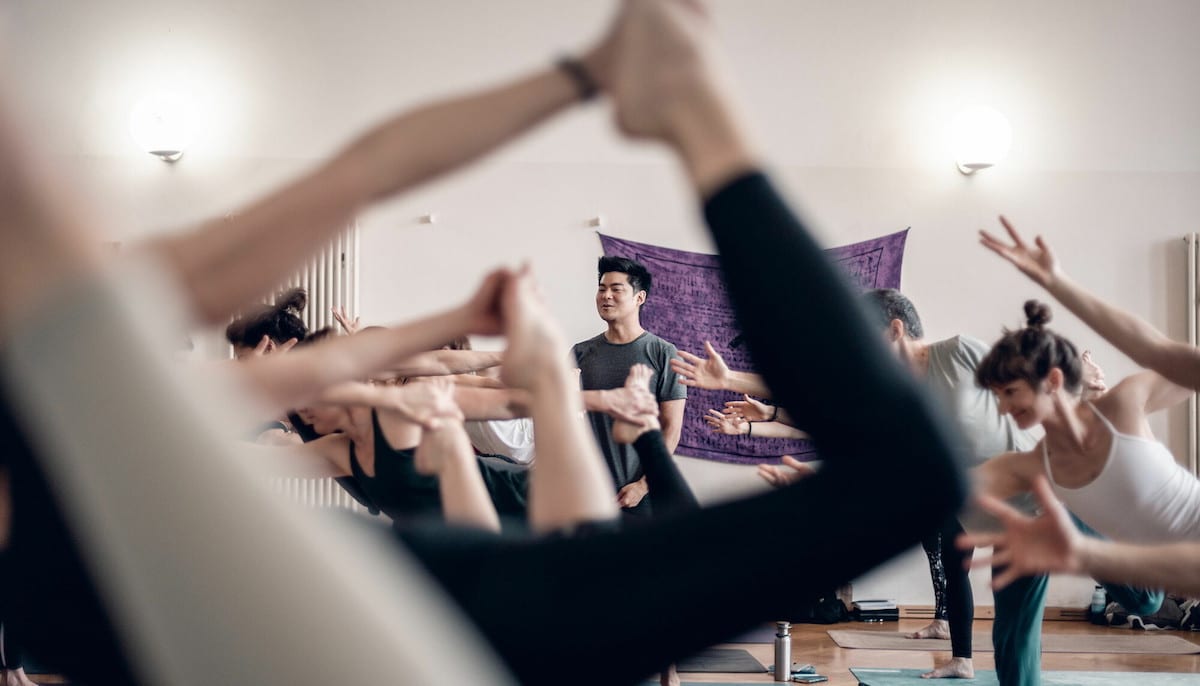
The benefits of balancing yoga poses affect you both physically and mentally. Photo by Light Spotters.
2. 10 Tips to Improve Your Balance in Yoga Poses
Standing stable and steady in balancing poses for several breaths can be challenging. The good news is that patience and regular practice will soon improve your sense of balance and give you a sense of achievement. This makes this type of yoga poses particularly satisfying, especially for beginners.
Here are 10 tips that help you improve your balance for your yoga practice.
1. Start at the Base
Although this applies to almost every asana, it is particularly important for balancing yoga poses. Always build the pose from the ground up. Start by aligning the feet, then the legs, upper body, and arms.
Also make sure that you first get a good sense of touch with the ground. Root down into the ground with either your feet, hands, forearms, or whatever forms the basis of the pose you want to practice.
As a last step, extend up through the crown of the head.
2. Fix Your Gaze
When trying to balance, keep your gaze fixed on a point that is not too far ahead and that doesn’t move. In yoga, this is called Drishti and is a means for developing concentrated intention.
3. Take Your Time
Move slowly and consciously into your yoga balance poses as abrupt and sudden movements may shake you out of balance and let you wobble and fall. It’s much easier if you come into a balancing pose with patience and awareness. Entering the pose too hastily puts you at risk of losing your balance. Furthermore, it’s much harder to re-gain your balance, once it’s you’ve lost it.
4. Get Support
There’s nothing wrong with getting some external help. You can, for example, practice near a wall or a chair. This way, you can place your hands on the wall or the chair. You can even practice balancing poses with your back against a wall.
Another possibility is to ask a fellow yogi to lend you a hand for support and stability.
5. Focus on Your Breath
A calm and steady breath can help you a lot to stay stable and still. The better you’re able to focus on your breath, the easier it will get to balance in these yoga poses.
6. Don’t Be Afraid
Although fear is a very useful warning sign to protect us from potential dangers, it’s often one of our biggest obstacles.
Try not to be afraid to fall down. Rather adopt a playful attitude and don’t take yourself too seriously. Enjoy the process of learning. Instead of being frustrated every time you fall out of a balancing pose in your yoga practice, laugh and try again.
7. Be Aware of Your Center Line
In yoga balance poses, it’s particularly important to bring your awareness to the center line of the body. This is the vertical line from the center of the head through the neck and torso.
Also, pay particular attention to the position and movement of the head. This is because your equilibrium receptors are located in the vestibular system in the inner ears.
8. Keep the Feet Hip-Width Apart
If you have difficulties balancing with your feet together, place your feet hip-distance apart or even wider (which is a more healthy alignment for your body anyway!). You can gradually step your feet closer together as you gain more balance in these poses.
9. Be Patient
No one is born a master. If you don’t manage a new balancing pose in yoga at the first attempt, don’t worry. Remember that everyone has to start somewhere. And you won’t achieve anything without regular practice – as it’s often the case in yoga, and in life.
So, if you fell out of a balance pose one day, try it again the next day, and the next. And at some point, the magic will happen!
10. Relax
Remember: It’s just yoga after all. You don’t have to prove anything to anyone. It’s your practice and your journey. Wobbling or falling in yoga balance poses is not the end of the world. It really isn’t.
So, keep your mind relaxed, enjoy your yoga practice, and your journey to balancing in yoga poses.
3. Five Yoga Balance Poses for Beginners
Remember: everyone has to start somewhere. So, if your new to yoga but still want to improve your balancing skills, then these five beginner yoga poses for balance are the perfect starting point for you.
1. Mountain Pose (Tadasana)
Yes, Tadasana is a balancing pose. It may just look like standing around but it actually requires you to be aware of every part of the body and maintain your sense of balance.
When practicing Mountain pose, always start with the alignment of the feet. Place them hip-width apart and press the four corners of the feet into the ground. Relax the toes and lift the arches of the feet. Then squeeze the feet and shins in toward the center of the body and push the thighs and sitting bones back and apart.
You also want to engage the abdominal muscles and stretch down into the feet and up into the crown of the head. The arms can rest right by the sides and the shoulders should be relaxed.
Although this balance yoga pose may certainly not look like much, it uses every muscle in the body when correctly executed. It can not only improve general posture and body awareness, but also strengthens the thighs, knees, and ankles. Tadasana is the perfect asana to start your balancing yoga practice.
Learn how to do Tadasana with Desirée Rumbaugh and Andrew Rivin on TINT.
2. Chair Pose (Utkatasana)
Five syllables that make every yoga student sigh and every yoga teacher feel like a drill instructor: ut-ka-ta-sa-na – Chair pose. But the burning sensation in your quads may not be the only thing you’re struggling with. Staying balanced in this yoga pose is also challenging.
Start in Mountain pose with the feet hip-width apart. Bend the knees and lower your hips as if you wanted to sit on a chair.
Lift the chest and raise the arms up overhead with the palms facing. Outwardly rotate your upper arms to avoid shoulder impingement.
Engage your legs by inwardly rotating your thighs. Shift the body weight slightly backward and tilt the pelvis to the front (anterior tilt). This will create a curve in your lumbar spine. Don’t forget to smile – this will make the pose a lot easier!
This asana is not only torture, it has plenty of benefits! It strengthens the entire legs from the glutes and thighs to the calves and ankles. Chair pose helps you to build stamina and tones your entire body – a great workout for body and mind.
Learn the correct alignment in Chair pose with Young Ho Kim on TINT.
3. High Lunge (Alanasana)
As soon as your feet are no longer next to each other, your balance gets challenged. This is why High Lunge is a yoga balance pose.
Start in Mountain pose and step one leg back. The front foot is firmly rooted into the ground with the knee directly above the ankle. Aim for a 90-degree bend in the front leg.
The back leg is straight with the weight distributed backward. Push the back heel back and down toward the ground. Pull the inner thighs toward each other and tuck the pelvis.
The spine is long and extended. Straighten the arms overhead and lift the chest. The palms of the hands are facing each other and can be together or separated.
This yoga pose helps you to find stability in the front and back of the torso. It stretches the chest, shoulders, arms, and neck as well as the abdominals and the back muscles. It also strengthens and stretches the thighs, calves, and ankles.
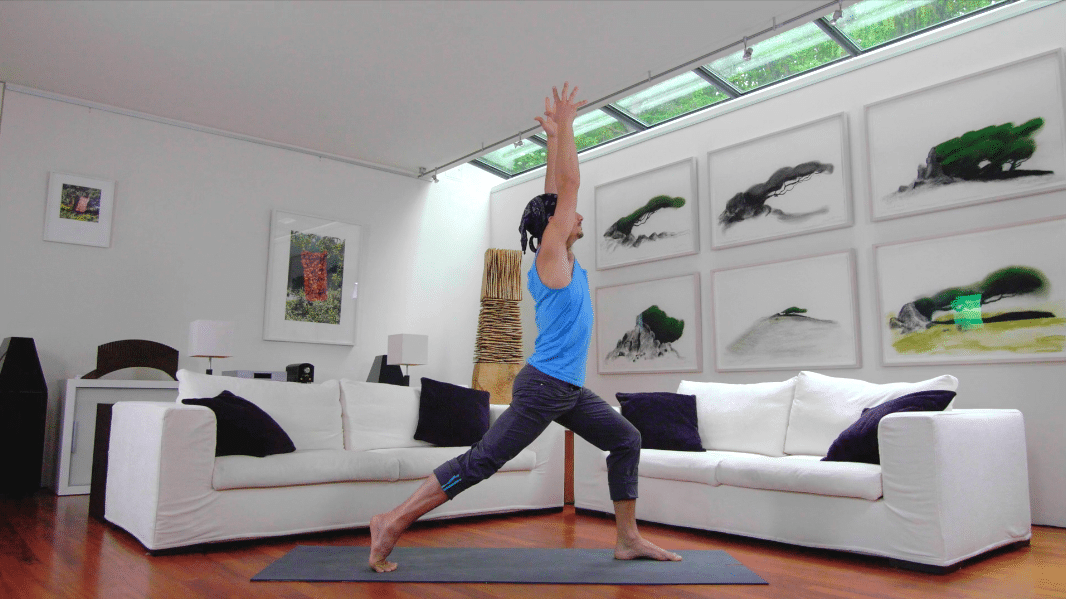
High Lunge requires balance in yoga because you step the feet apart. Photo: TINT Instructor Matt Giordano.
4. Tree Pose (Vrksasana)
Tree pose is one of the first one-legged standing balancing poses practitioners of yoga learn. Since you can’t stand still when your mind is all over the place, unsteadiness and lack of focus can turn this yoga balance pose into a mirror of your inner state.
Start in Mountain pose (see a pattern for balancing poses in yoga here?). Shift your body weight into one leg, keeping the inner foot firmly on the floor. This will be your standing leg. If you feel unstable standing on one leg, you can also practice against a wall.
Raise the other leg up and bend the knee. Then, reach down with the hand and clasp your ankle. Place the sole of the foot against the upper thigh of the standing leg with the toes pointing down. If you can’t bring your leg up this high, you can also place it lower down. Please be careful here to not place it directly against the knee. Bring it above or below the knee joint instead. Squeeze the lifted foot into the femur bone of the standing leg and vice versa.
From inside your ribs, stretch your spine down toward your legs and up through the top of the head. Gaze softly at a fixed point on the floor in front of you – your Drishti. Once you feel stable, you can take your arms up overhead.
Tree pose is a great asana to strengthen your entire leg – from the thigh to the calf, ankle, and foot muscles. It also helps you gain strength and length in your core and spine and, thus, helps you to improve your posture and balance.
Learn how to improve your balance in Tree pose with Desirée Rumbaugh and Andrew Rivin on TINT.
5. Warrior 3 (Virabhadrasana 3)
Actually, all Warrior positions, i.e. including Warrior 1 and Warrior 2, require a certain amount of balance. But having one leg lifted in this Warrior pose makes it a more challenging balancing pose in your yoga practice.
Start in a standing position such as Mountain pose (I told you!). Keep one leg rooted and perpendicular to the ground while raising the other leg and extending it backward. Press the top of the standing leg back toward the heel and push it firmly into the ground. Stretch your arms and the extended leg away from each other.
Keep the hips squared and press the tailbone firmly into the pelvis. The arms, torso, and extended raised leg should be positioned relatively parallel to the floor. The gaze is forward or down.
Warrior 3 is a great balancing pose that also strengthens the ankles and legs as well as the shoulders, abdominals, and back muscles. It will certainly improve your balance and posture.
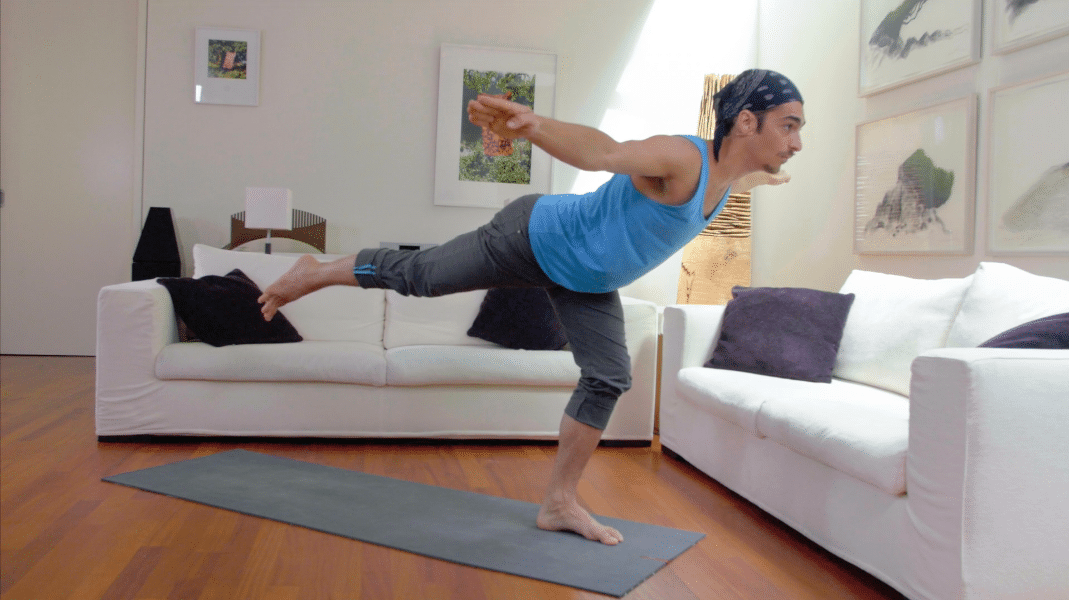
All Warrior poses help you improve your balance in yoga. But Warrior 3 is definitely the most challenging one. Photo: TINT Instructor Matt Giordano.
Now it’s time that you roll out your yoga mat and start playing with some beginner yoga balance poses. Matt Giordano’s class Focus does exactly what it says on the label: find focus and steadiness in a series of beginner yoga poses for balance.
You can also choose to let Hie Kim take you through the Anatomy of Balance in his beginner-friendly balancing yoga class.
Being balanced and steady is essential for having a solid foundation. Balance your first Chakra to find this groundation with Faith Hunter in her 1st Chakra Practice.
4. Five Advanced Yoga Balance Poses
Ready to take your balancing poses one step further? Then let’s explore some more advanced yoga poses for balance. Don’t forget to keep your playful attitude and leave your ego outside the yoga mat.
1. Half Moon (Ardha Chandrasana)
Although the poses get a bit more advanced, the starting point is still the same: Tadasana. From there, extend one leg back so that it is parallel to the ground and flex the foot. The hand of the standing-leg side is on the floor in front of you and slightly outwards. Straighten the other hand is up so that the fingertips move in opposite directions.
The body weight should mainly be supported by the standing leg so that there’s very little weight on the bottom hand. Rather use it only to control your balance.
Avoid collapsing the torso down but rotate it toward the sky instead. You can look either up or down, depending on the condition of your neck.
Apart from improving your balance, this yoga pose also strengthens the abdomen, the ankles, the thighs, the buttocks, and the spine. It also stretches the legs, the shoulders, the chest and the spine.
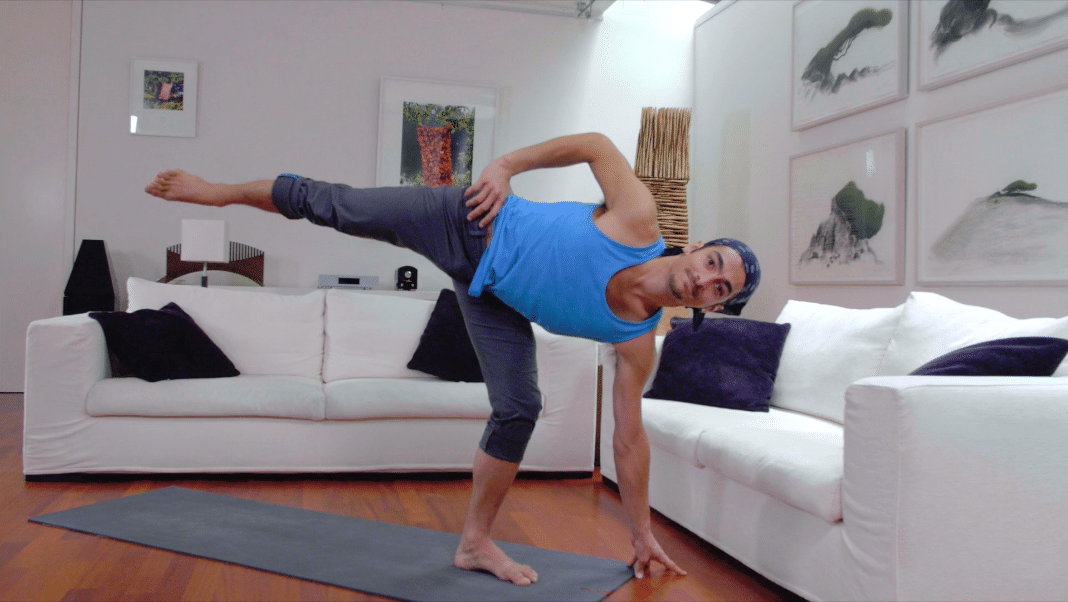
Take your yoga balance poses one step further with Half Moon pose. Photo: TINT Instructor Matt Giordano.
2. Dancer’s Pose (Natarajasana)
If you’ve managed Half Moon, Dancer’s pose is not far away from you. This advanced yoga balance pose is a great reminder to maintain a playful attitude while trying to stand on one leg.
Start standing in Tadasana and bring the bodyweight onto one foot. Bend the knee of the other leg and begin to lift the heel up toward the buttocks. Reach back with the hand of the same side to grasp the outside of the foot or ankle. Push the foot into the hand and vice versa to lift the bent leg and foot further away from the ground.
Only when you can’t lift the leg any further, start bending the torso forward. Reach the arm of the standing-leg side out to the front. Your gaze follows your fingertips.
Avoid compression in the lower back by actively lifting the pubic bone toward the navel. At the same time, press the tailbone down toward the floor.
Balancing in this pose strengthens the legs and ankles. It also stretches the shoulders and chest as well as the thighs, groins, and abdomen.
Balance in Dancer’s pose and other balancing asanas in Kristin McGee’s Dancer’s Flow on TINT.
3. Eagle Pose (Garudasana)
Let’s add some knots to your advance yoga balance poses. Eagle pose does not only challenge your sense of balance and coordination, but also provides a great stretch for the thighs and hips, and the shoulders and upper back.
Start in a standing position and cross one thigh over the other. If available to you, you can also hook the toes and/or the ankle behind the calf of the standing leg. Balance your body weight on the standing leg.
Now also cross the arms in front of the torso so that one arm is crossed above the other one. Tuck the top arm into the elbow crook of the bottom arm. If possible, also hook the hands around each other. Lift the elbows up and away from you. Sink down lower in the hips.
Although this pose requires a lot of concentration, try to keep the gaze forward and soft.
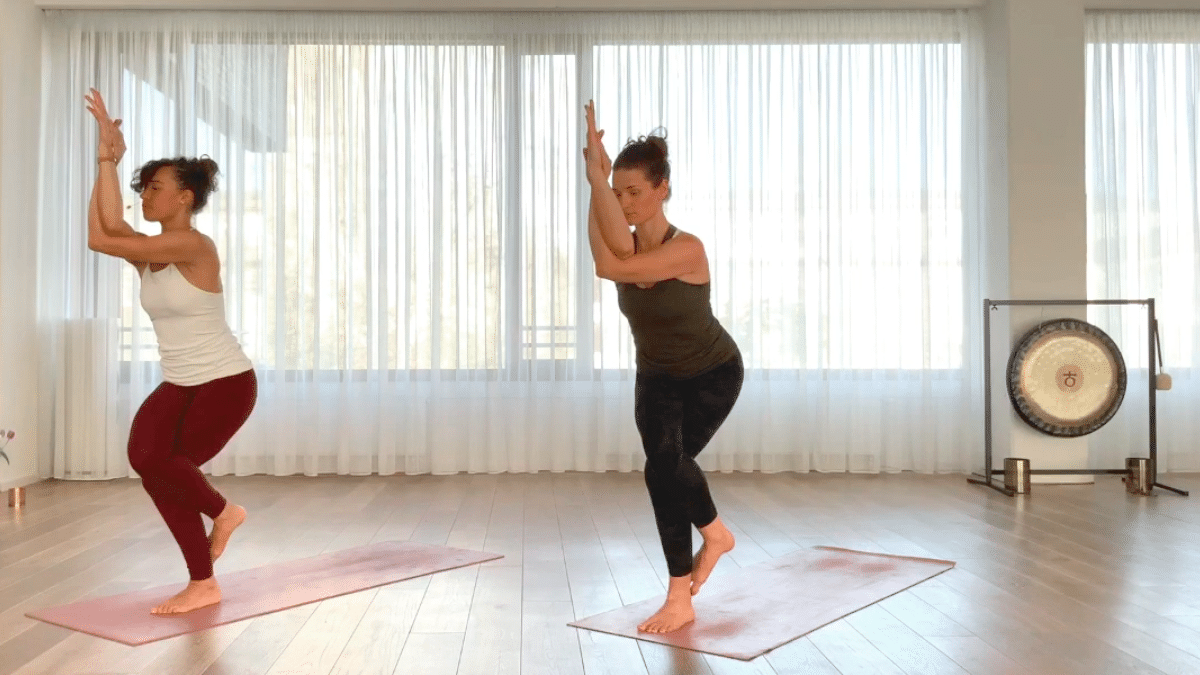
Balance and stretch in Eagle pose. Photo: TINT Instructor Ami Norton.
4. Hand-to-Big-Toe Pose (Hasta Padangustasana)
This pose is not so much advanced because it requires a high level of balance, but rather because you need to be quite flexible, especially in the hamstrings.
You probably guessed that you start in Mountain pose. Shift your body weight onto one foot, rooting firmly down into the ground. Bend the knee of the other leg and pull it up toward the chest using the arm of the same side to hug it in.
Hook the index and middle finger around the big toe and straighten the leg out in front of you. Keep your hip and shoulders squared by placing the free hand onto the hip. If you can’t straighten the leg completely, it’s fine to leave it bent or use a strap around the lifted foot. Focus your gaze on a point in front of you and maintain a steady breath. This will help you to balance in this yoga pose.
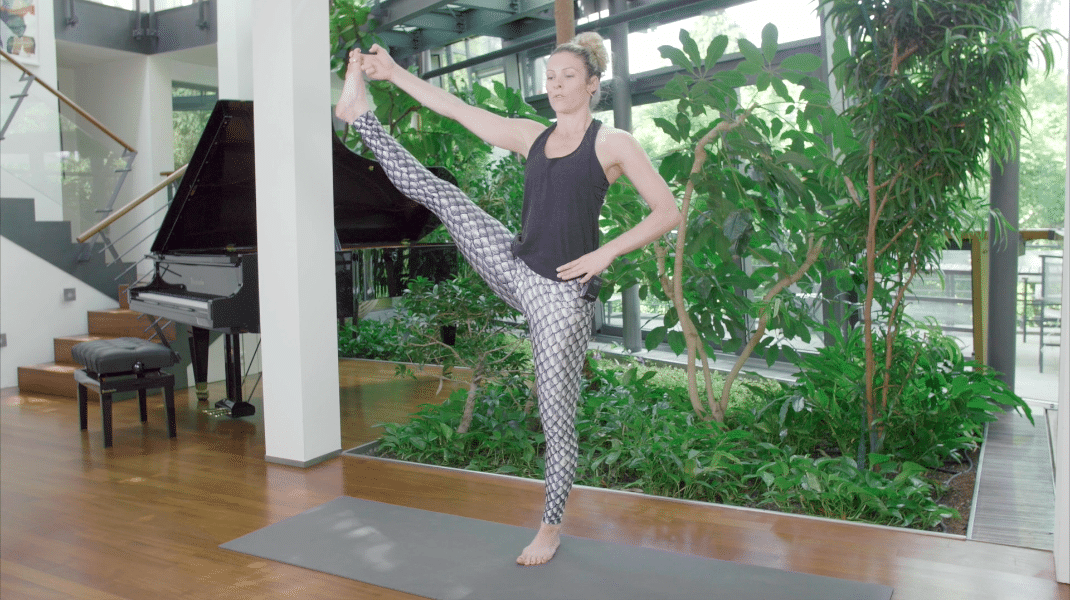
Challenge yourself with Hasta Padangustasana in Alex Hardfields Bind & Balance class on TINT.
5. Bird of Paradise (Svarga Dvijasana)
This is a great yoga balance pose to be playful. Bend forward from Tadasana and slide one hand between your legs and walk it backward as far as you can. Wrap it around the leg of the same side and place the back of the hand onto your lower back.
Reach the other hand back and try to clasp your fingers or even your hands behind your back. If this is not possible, use a strap.
From here, look forward as if you were in Cobra pose. Bring the feet a little bit closer together and lift the heel of the wrapped leg. Open the chest and keep creating this Cobra-pose feeling as you slowly start lifting your torso up until you stand upright.
You can stay there or extend the leg toward the sky. Keep the ribcage lifted and the heart open in the full expression of the pose. And, most importantly, don’t forget to smile.
This is probably the most advanced yoga balance pose in this series as it also requires a lot of flexibility in the spine, hips, and hamstrings. It also stretches the shoulders and strengthens the legs.
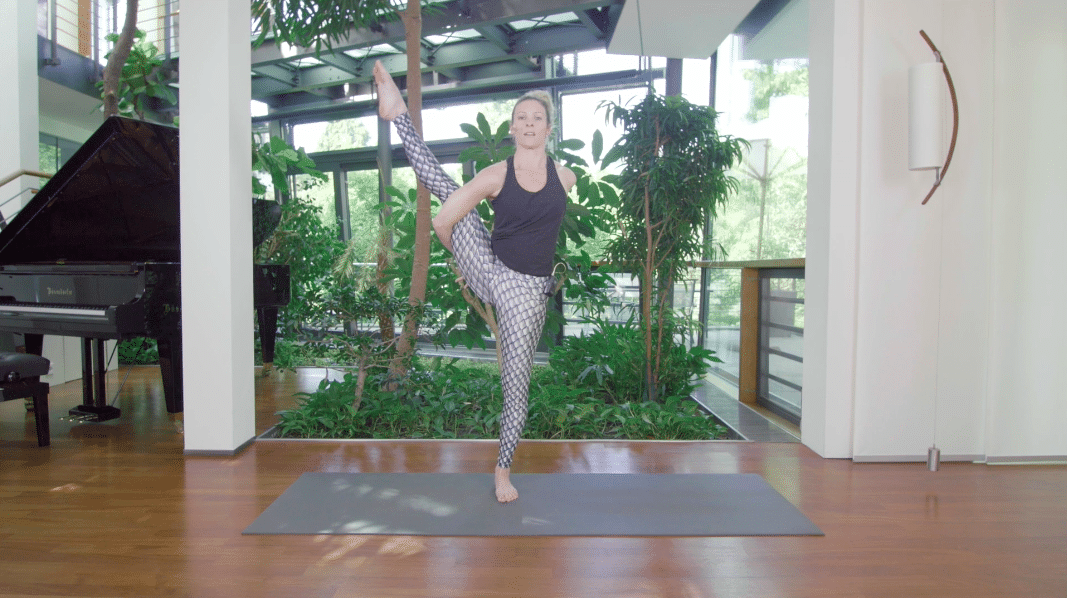
Enjoy a challenging yoga sequence with the peak pose Bird of Paradise in Alex Hardfields Bind & Balance class on TINT.
If you want to try this pose in a well-rounded sequence, hop on the yoga mat with Alexandra Harfield in her class Bind & Balance. She also created a whole workshop on TINT focusing on Dips, Binds, and Balances.
You also find a variety of challenging balancing poses in Sianna Sherman’s yoga sequence Way of the Warrior. You can also work on Strength & Balance with Alexey Gaevskij or try an entire yoga sequence without using your hands in Ami Norton’s Hands-Free Flow. These yoga classes will definitely improve your balance!
Whichever class you decide to take, always remember that yoga balance poses are difficult at first. But over time, your sense of coordination and balance will improve. With patience, dedication, and – of course – regular practice, you will soon improve your focus and your ability to stay stable and centered.
And the best thing about balancing poses in yoga is that the steadiness you gain in the poses will also bring more balance in all areas of your life – also off your yoga mat!













